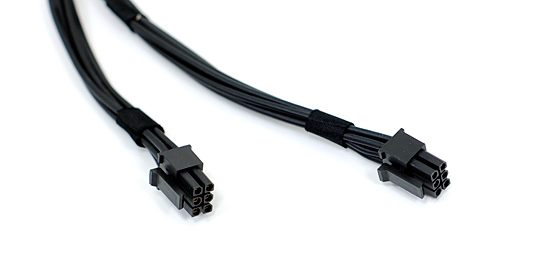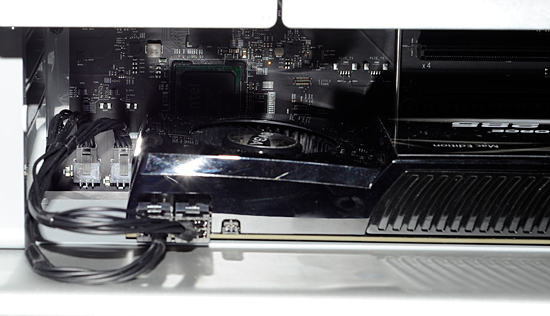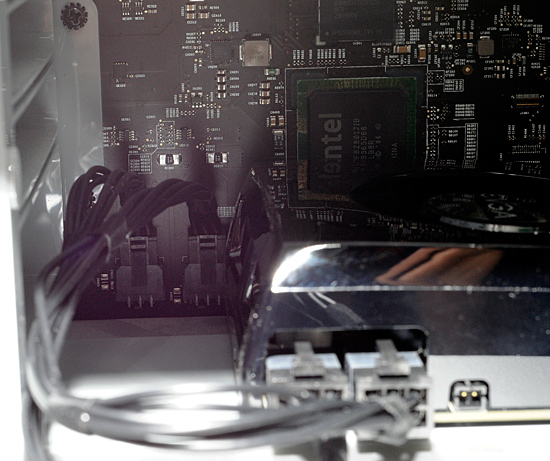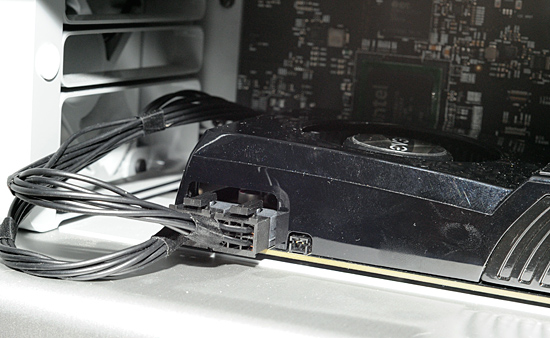EVGA's GeForce GTX 285 Mac Edition: The Best for OS X?
by Anand Lal Shimpi on July 17, 2009 7:00 PM EST- Posted in
- GPUs
Installing EVGA's GeForce GTX 285 Mac Edition
EVGA’s GTX 285 will only work on 2008 - 2009 model Mac Pros, the original 2006 model is not supported. Bummer.
The first step to install the card is actually to install the drivers. If you fail to do so, you’ll be greeted with a kernel panic once you get the card installed and fire up the machine. The drivers are available both from NVIDIA’s website and on the driver disc EVGA ships with the card.
After the drivers are installed, turn off your Mac Pro and remove the side panel. There are two thumb screws (that need to be unscrewed with a screwdriver) that hold a bracket in place, which in turn holds your expansion cards in place. Remove them and it.

Remove these
There’s a metal bar that holds all of the PCIe cards in place, you’ll need to pull that back while you pull your existing video card out. You’ll need to pull it back while installing the new card as well.

Pull this bar back while you remove your old card and again when you install the new one
The Mac Pro is highly compartmentalized; to the far left of the PCIe slots there are two small connectors that look like PCIe power connectors. You’ll need to connect both cables that came with the card to these connectors. They only go in one way. The other end of the cables goes into the GTX 285.




Before installing the card you’ll need to remove one additional bracket cover (assuming the previous resident was a single-slot card). Slide in the EVGA, replace the retention bracket, close the case and hit the power button.










48 Comments
View All Comments
bupkus - Saturday, July 18, 2009 - link
For so very long linux never could claim itself a good platform for games. So I'm thinking, admittedly quite wishfully, that the OS X's linux roots could provide a trail for drivers in OS X to become useful in linux.What say you experts on this matter?
erple2 - Saturday, July 18, 2009 - link
OSX isn't based on Linux. It's based on a BSD flavor. I'm not sure if it's NetBSD or OpenBSD (I think NetBSD). Which is very different from Linux.Kurotetsu - Tuesday, July 21, 2009 - link
Well, according to Wiki (which means you should take it with some salt), it was both:Mac OS X is based upon the Mach kernel.[8] Certain parts from FreeBSD's and NetBSD's implementation of Unix were incorporated in Nextstep, the core of Mac OS X. Nextstep was the object-oriented operating system developed by Steve Jobs' company NeXT after he left Apple in 1985.[9]
http://en.wikipedia.org/wiki/Mac_OS_X">http://en.wikipedia.org/wiki/Mac_OS_X
sprockkets - Tuesday, July 21, 2009 - link
Yes, this is true. The BSD part is just for POSIX compliance. Even though OSX is certified UNIX, Apple saying it is UNIX stable is a bit disingenuous, as the part of the kernel doing all the work is all Apple, not UNIX or BSD.8steve8 - Friday, July 17, 2009 - link
means can't connect to the LED 24" display apple makes.weird.
Natfly - Saturday, July 18, 2009 - link
I would think a standard dvi -> mini-displayport adapter would work, right?http://www.monoprice.com/products/product.asp?c_id...">http://www.monoprice.com/products/produ...2&p_...
BrianMCan - Monday, July 20, 2009 - link
no, that is to connect a DVI monitor to mini-displayport computer.to go the other way it would have DVI male, to mini-displayport female.
Demon-Xanth - Friday, July 17, 2009 - link
...the markup on those cables is the most I've seen outside of audiophile or specialty cables.
Connectors:
4x Molex 45559-0002 $0.30ea, $0.14/ea in quantities of 5000
24x Molex 44476-1111 $0.12ea, $0.05/ea in quantities of 4000
12' 18AWG stranded wire (assuming the cables are 12") $38/100 foot spool, $145 for 1000'
(prices from Mouser, distributors may be much lower)
Low quantity cost: About $8 for the pair.
Higher quantity cost: About $3 for the pair.
Admittedly, the crimp tool itself runs about $320, so given the $52 profit margin, it should take about 7 sets to end up in the black.
rpmurray - Tuesday, July 21, 2009 - link
I'd go with the higher quality pair, according to you they're $5 cheaper then the low qualityDemon-Xanth - Thursday, July 23, 2009 - link
Quantity, not quality.The parts are $8 for two if you built one set. $3 for two if you build 1000 sets.